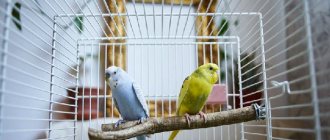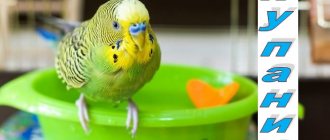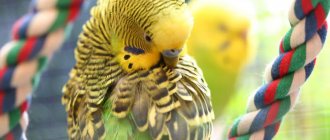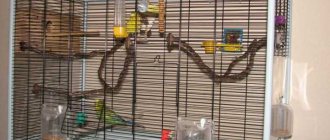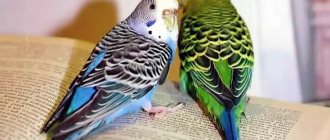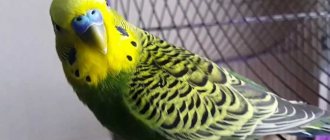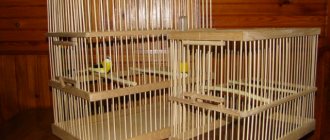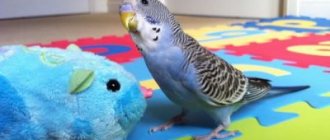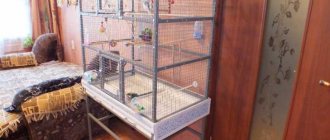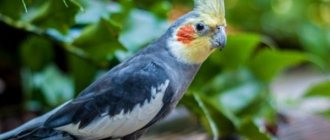- doors open from top to bottom,
doors open from bottom to top,
Fans believe that not all options are equally good. Often, after cleaning, owners forget to close the door of the parrot's house. In the case of the fourth option, this can be avoided, because the door itself lowers and closes. You can make a cage for your feathered pet yourself
What material is used for the cells?
One of the most important characteristics when choosing a house for a pet is the material from which the parrot's home is made. Cages for feathered pets can be:
- Metal. Such options are most often found on the market. The best option would be if the cage is an all-metal product. Such houses transmit light well, are not affected by disinfectant solutions, and are not afraid of moisture. When choosing a metal, you should avoid copper products. Such a cage becomes covered with moisture due to oxide, which is poisonous for feathered pets.
- Wooden. These cell options have a beautiful aesthetic appearance. However, they get dirty easily. When cleaning, such houses absorb moisture along with detergents, which will negatively affect the parrot’s well-being. In addition, feathered pets love to chew on wood, so such a building can quickly become unusable. Options for combined cages with a wooden frame and metal rods are also not a good option for a parrot.
- Made from synthetic materials. Such plexiglass cages create good competition with metal options. They are also not afraid of moisture, do not respond to aggressive cleaning agents, and look original. However, such houses also have their disadvantages: they are vulnerable to high temperatures, which is why they are fire hazardous products.
Toys and mirrors
There are a lot of inexpensive Chinese consumer goods on sale, and poultry markets have also been completely conquered by them. Because of these cheap plastics we are losing our feathered pets. Parrots of all breeds chew on everything, like mongrel puppies.
And then they swallow plastic fragments and die. Owners need to check very carefully every item they decide to buy for their pet.
An excellent solution is metal bells that can be hung in a cage: ringing and fun for both people and birds. Offering mirrors is also dangerous: the beaks are strong, and the glass is fragile. If a sharp piece of glass is swallowed, you will not be able to survive. But the owner is the master, let him decide for himself.
What types of parrot cages are there?
The following types of cages are offered for parrots:
- Small. This cage is a good option for small pets. It can also be used when transporting a parrot if there is no special carrying cage.
- Average. This cage option is well suited for wavy lovebirds. There is more space here so that the bird can freely open its wings.
- Big. This cage is suitable for larger birds. Rosella, Corella, and Gray will feel comfortable in it.
- Aviary. This is a cage that is used not just to house pets, but also to breed them.
- Carrying. If you are traveling with your feathered pet, then it will not be easy for you to do without a carrier cage. This cage, made of iron or plastic, is used to transport pets over various distances.
Doors
Doors are of the following types: 1) the door opens to the side; 2) the door opens from bottom to top; 3) the door opens from top to bottom; 4) guillotine-type door sliding up and down.
The best option is a door that opens to the side (like an entrance door), or a door that goes down. Avoid guillotine doors (those that slide up and down over bars). For restless birds that constantly strive to escape, such a door poses a great danger - it can simply fall on the bird’s neck.
The size of the door should be such that a hand and a parrot can easily fit into it.
The home of a large parrot must be equipped with a lock. Some manufacturers have developed unique locks that even the smartest bird cannot handle.
How to choose a place for a parrot's cage?
In order for your pet to be in a good mood and delight you with its excellent health, you need to choose the right place where the pet’s cage will be located. It is worth considering the following nuances:
- It is desirable that the parrot's home is at a level with the height of the owner. If the cage stands low, the bird will often be depressed, but if the cage stands high, the pet will try to dominate.
- It is advisable to place your feathered friend’s home in the room where the owner spends the most time. In such a situation, the parrot will not feel lonely.
- When placing the cage, it is worth choosing a place so that at least one side of the bird’s house is pressed against the wall. The best option would be if the cage is in the corner. In this case, the parrot will feel protected. However, you should not place your parrot's cage in a dark place where there is no access to sunlight.
Pallet
Many cages have plastic trays that are easy to wash and remove during regular cleaning. It is recommended to rinse this part of the bird’s home under running warm water. Large cages for several birds have several pull-out trays. This is very convenient for regular pet care. It is recommended to cover the bottom of the tray with plain paper or fill it with special dry sand or other safe filler, which is sold in pet stores. Attention! Most cat litters are not suitable for birds!
What places should you not choose to place a parrot cage?
Your pet’s comfortable state of health, its state of health, and mood depend on the choice of place where the cage with your feathered pet will be located. Experts say that there are restrictions on where you should not place your feathered pet’s home:
- near objects that make loud noise (household appliances, TV). Such noise can simply unsettle the parrot and frighten it.
- next to heating devices (radiators, convectors). Temperature changes and too hot air can negatively affect the pet’s appearance and condition.
- in places where drafts are possible. Parrots can tolerate cold temperatures, but drafts can cause deterioration in your pet's health.
- near devices that emit radio waves. Invisible radiation can have a very negative impact on the condition and well-being of your feathered friend.
- in places where the sun's rays often hit. Warmth and sun are good, but the parrot must have a place where it can hide from direct hot rays.
- near the window. Here the feathered pet can acutely sense temperature changes. and if the window faces the road, then it is impossible to avoid loud noise that can frighten the parrot.
- in the kitchen. In the kitchen, in addition to appliances with electromagnetic radiation, windows are often opened during cooking, which leads to drafts. In addition, when cooking indoors it becomes hot, there is a lot of fumes, which will not improve the well-being of your feathered pet.
Dimensions
If you choose a cage, stores will offer you many different types. As they say, for every color and taste. Due to such a variety of products, any buyer can get confused. Therefore, you should know what exactly your pet needs. Now we'll talk about sizes. Let's find out how to choose the right cage for a budgie in terms of size.
Inappropriate values
You should never buy a very small or, conversely, too large cage. If your budgie doesn't have enough space in its home, it may become nervous or feel apathetic. In addition to psychological difficulties, the likelihood of injury and gaining excess weight increases. Physical endurance also decreases. The bird's muscles are weakening. Since due to the small space for movement, she cannot lead an active lifestyle. Birds are also uncomfortable in huge store-bought or home-made cages. Therefore, you need to know the appropriate cage sizes for one, two, that is, a pair of budgies, or for several pairs. Next we will tell you how they are calculated.
How to determine the required parameters?
The ideal space for a cage is determined as follows. A bird sitting in the middle of a perch can easily spread its wings without touching the walls. In addition, it is necessary that 2 or 3 perches be placed there, from which the parrot could safely fly from one place to another without touching anything.
Taking this into account, approximate cage sizes for budgerigars were identified. They are suitable for 1 or 2 birds . The cage should be in:
- height: 35 - 40;
- width: 25 - 35;
- length: 60 - 80.
The cell dimensions are indicated in centimeters.
If you have not one, but two pairs of budgies, then the above values should be multiplied by two .
What should a parrot's cage be equipped with?
Comfortable conditions for a feathered friend are a good quality cage, which is equipped with all the accessories necessary for a parrot. Your pet's house should have:
- Drinking bowl. Now on the market there are various options for automatic drinkers made of glass and plastic, the advantage of which is that garbage does not get into them. In such containers, water remains suitable for consumption longer and retains freshness. The water in the drinking bowl should be at room temperature.
- Feeders. Fans say that there can be three such feeders: one for grain, the second for berries, juicy food options, the third for organic sand and mineral mixtures. Feeders should not be located near the water bowl so that your feathered friend has less chance of throwing pieces of food into the water. Feeders should be smooth, wide, and placed in easily accessible places.
- Perches. For comfort, it is necessary that the parrot has two or three perches in its cage. Accessories made of soft wood (birch, willow) help the parrot feel comfortable, but perches made of bamboo and plastic can lead to the appearance of calluses on the paws, which will negatively affect the well-being of the pet.
- Bath. This accessory should not be kept in the house all the time. The bath must be placed in the cage so that the parrot can take water treatments. After bathing, the bath must be immediately removed from the cage so that your feathered friend does not drink dirty water. In the summer, the frequency of such bathing may increase; at a minimum, such a procedure should be carried out once a week.
- Toys (swing, ball, bell, mirror). All these accessories will help your pet not feel lonely while the owners are away from home. However, you should not fill all the free space of the cage with toys. The parrot should have space.
- Chalk. For a parrot, a lack of calcium is dangerous, so there should always be chalk in his house, purchased at pet stores.
Having created a comfortable home for your pet, do not forget that the parrot needs communication with the owner in order to feel comfortable. Even in the best conditions, a pet can have health problems if it lacks attention, care, care, and communication.
Feeders and drinkers
A pet needs different types of food: soft, mineral and grain. And that’s not all: you need to separately add charcoal, eggshells, and river sand, which are necessary for the normal functioning of the digestive system.
Read also
How to name a boy's budgerigar list of names
It is impossible to put all this in one bowl. For food, three containers are usually purchased and installed at once. They must be made of stainless steel and of suitable size. So are drinking bowls.
Preparation
A list of parts should be compiled, consisting of groups of elements whose size parameters and purpose are the same.
- Wooden components are sawn off from the workpiece in accordance with the specified dimensions. The cut areas are sanded with sandpaper until smooth. The presence of wood chips and splinters is excluded.
- The metal mesh is cut using metal scissors in accordance with the established dimensions. It is unacceptable to leave open cells at the edges of the mesh fabric. The cutting points of the mesh links are processed with sandpaper to eliminate the possibility of injury during the assembly process and harm to the parrot.
Preparing parts according to the principle of grouping facilitates assembly and reduces the time spent on it.
The structure is assembled according to a modular principle. The walls, top and bottom parts are assembled separately. Wooden slats are connected to each other in accordance with the drawing instructions. In order to avoid cracking of the wood in the places where the screws are screwed in, the mounting hole is drilled using a drill whose diameter is half the diameter of the threaded part of the screw.
In addition, a secret recess is drilled into which the screw head fits. For this, a feather drill with a diameter equal to the diameter of the head is used. A feather drill allows you to drill without chipping, and also ensure the conical shape of the sink, which will ensure the quality of the screw head fits in it.
The metal mesh is attached to the slatted frames using finishing nails. Their advantage is the presence of a small head, softness of the material and the ability to control the working length. The nails are driven into the slats in such a way that when bent, they can overlap the mesh bars at the point of their contact. The frequency of driving nails will be optimal if you drive them through 1-2 mesh links.
The assembled components are assembled into a single structure. As parts that enhance the strength of the connections, metal perforated corners are used, which are screwed using screws of the appropriate length.
Self-tapping screws tend to gradually unscrew as a result of the wood's susceptibility to expansion and contraction processes caused by its reaction to changes in temperature and air humidity.
On one side of the cage there should be a frame that allows for the installation of a door. It consists of two rack and pinion circuits. The outer contour is the base to which the door frame is attached.
The hinges holding the door on itself must be on the outside. This way you can limit the bird's ability to have access to iron parts.
The cage design must include a double bottom. The first is a metal mesh, and the second is fiberboard. When designing a cage, it is necessary to take into account the availability of access to the second bottom. This will allow for regular cleaning of the cage.
Watch the video tutorial on how to make a parrot cage with your own hands below.
Creating a nesting house
You can make a nest for your cockatiel with your own hands, suitable for breeding birds. This nest is suitable for breeding birds. In order for parrots to lay eggs, you need to create ideal conditions for them.
Form
The nesting house can be of different shapes, both vertical and horizontal
It is important that it meets the following conditions:
- Several birds can easily fit into the house. It is enough for the parrot and the laying of eggs, as well as for the hatched babies.
- There is a small recess made in the bottom. It allows the eggs in the clutch not to move.
- There is a door on top or the roof is removable. This is needed for cleaning.
Dimensions
The nest should be roomy and spacious. The following dimensions are optimal for a vertical house: 25 length, 25 width, 30 height. For a horizontal house the following dimensions are needed: 30*30*40 cm.
Horizontal is considered the most convenient and comfortable for birds.
Materials
The material you can use is cardboard or wood. A paper house is built quickly, but it is short-lived. Ornithologists recommend using a cardboard nest only in case of emergency, in case of temporary housing for birds.
Blueprints
Drawing of a small house for nesting birds. Equipped with an opening roof, an opening door and a small perch.
A more detailed drawing of the socket with indicated dimensions. The specified parameters are suitable for large cockatiels.
Step by step assembly
- Saw the plywood into 6 parts: 4 walls, roof and bottom.
- Cut a small hole in the wall with a diameter of 8 centimeters. Make a hole underneath for the perch.
- Fasten the walls and floor with self-tapping screws.
- Make a small nest out of polystyrene foam and place it on the bottom of the house.
- Attach the roof to the hinges.
- Install hooks to secure the house.
- Make a perch for the door.
- Fill the bottom with sawdust.
Disinfection and installation
To disinfect, you need to scald the house with boiling water and a disinfectant. After this, dry the plywood well in the sun. You should not install a wet nest, otherwise the material will begin to rot.
The use of toxic disinfectants is not recommended. They can be dangerous to birds.
Previous CorellaAll diseases of Corella parrots Next CorellaTaming, care and maintenance of the Corella parrot
